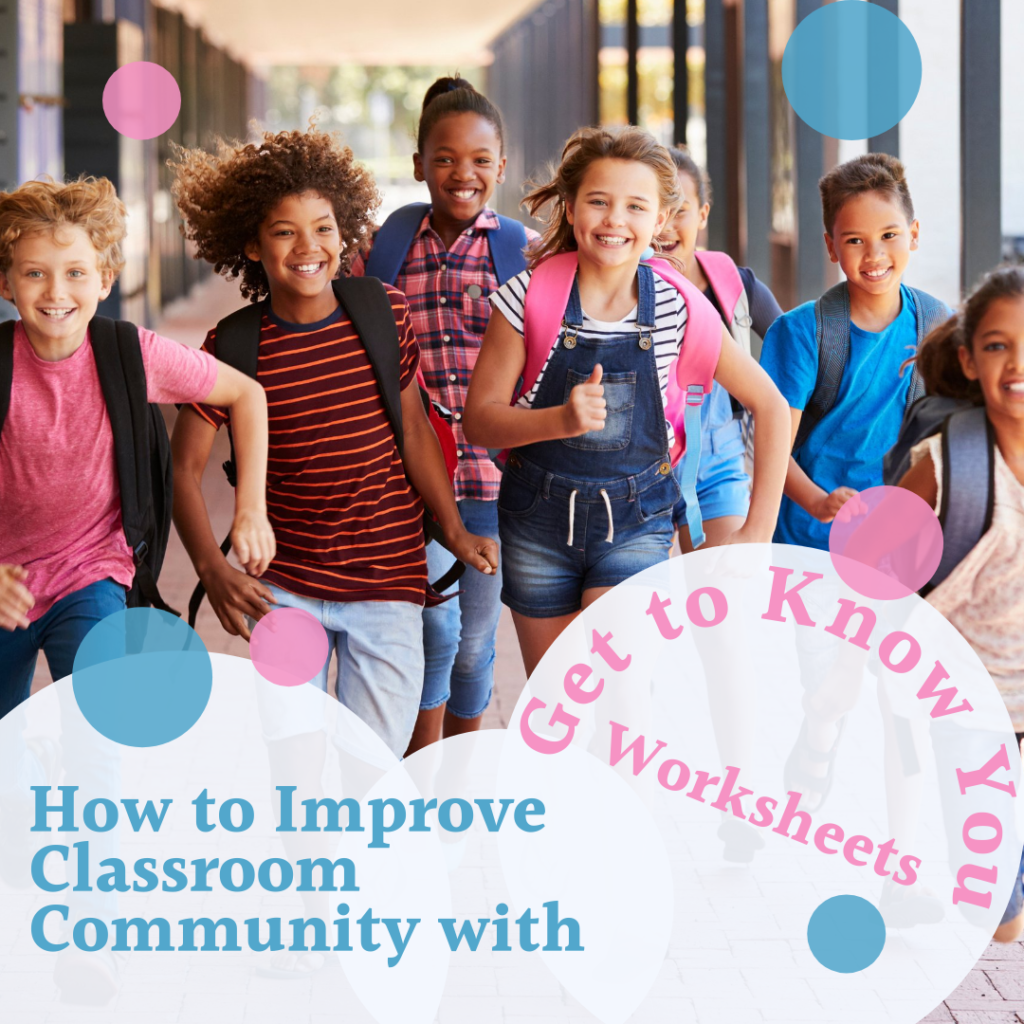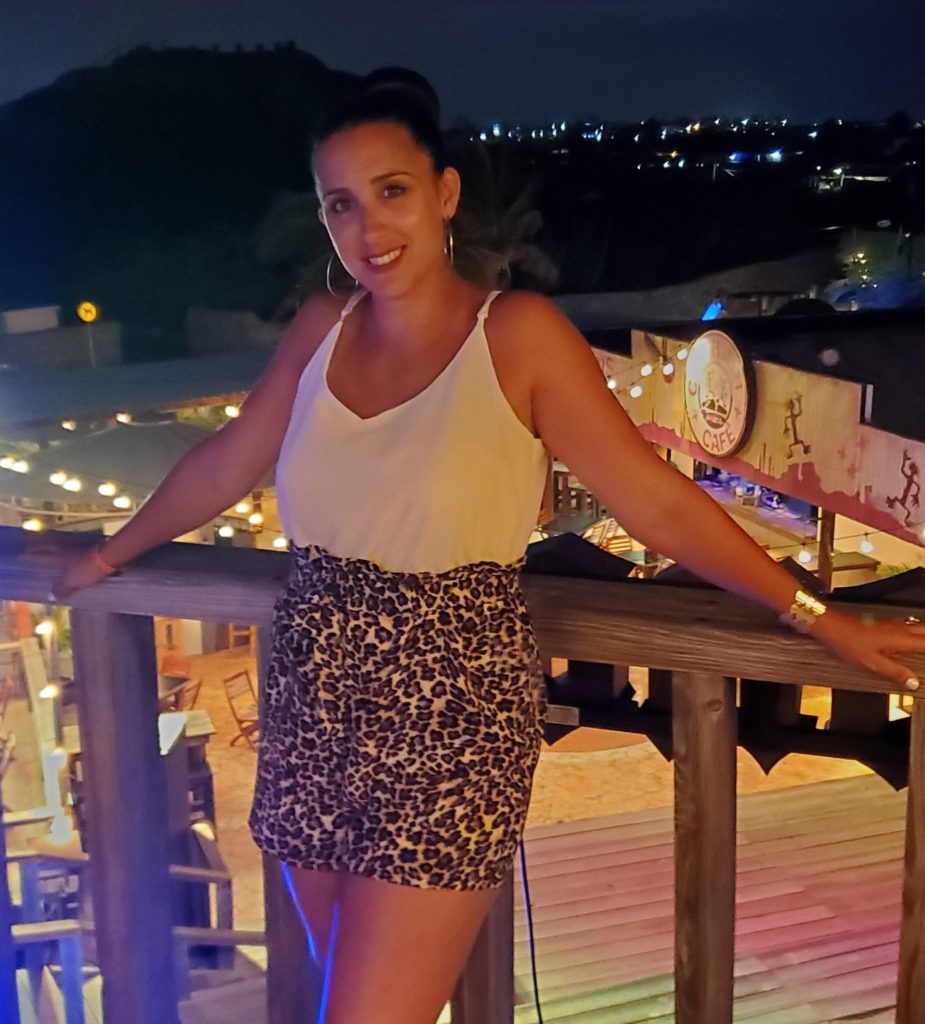Get to Know You Worksheets for Middle School Make the Start of Your Year Successful
Get to Know You Worksheets are an integral part of the start to my school year. I’ve always put a lot of thought into what to do the first days of school. There’s a constant conflict between when to start curriculum and when to continue fostering relationships.
Remember the roll out of Common Core? (I’m dating myself – ahh circa 2014!) We were all FREAKING OUT over Modules! So I will admit – there have been a couple of years where I have prioritized Math instruction over the more lighthearted activities where we all get to know one another. My conclusion? That almost always backfires.
The relationship between a teacher and a student is paramount to everything else that happens in the classroom. And the relationships forged between the students will determine, to what extent, the classroom will run like a family unit. Get to know you worksheets have been a wonderful way to start the year with classroom community in mind!
Of course, this is only one of many elements that go into creating a successful classroom environment and successfully making it through the school year. If you feel that you are juggling too many teacher responsibilities and neglecting any one area over another, please grab a copy of my free guidebook: 9 steps to avoid teacher burnout!
Put Your Students’ Developmental Well Being First with Get to Know You Worksheets
Get to know you worksheets for middle school proved to work really well with the psychological development of adolescents. My background in Adolescent Psychology DROVE me to middle school! I knew that there was something phenomenal going on in the brain of my 12 year olds. This is the time that autonomy would become the number one priority of the child. I had an opportunity to provide children the chance to feel comfortable being themselves in the Math classroom!
Now hear me out – in the beginning of my career, when I didn’t have the best grasp over classroom management, I had a harder time getting the ball rolling when it came time to get to work! That transition from “let’s have fun” to “let’s do Math” was rough as a twenty-something fresh out of a classroom myself! But I’ll never deny that the connections I made – and the safety and security I provided to students to be themselves, ALWAYS translated into a more willing participant in the classroom. Some students don’t make it that obvious for you right away. But if you stay positive and continue to follow through with the advantages I’m going to describe, you will see even the most reluctant learner come around!
Just this past year after being out of school for months because of Covid, I watched the student who – LITERALLY – cried at the thought of working in my classroom, transform into one of my top students who was always willing to share her thoughts and help out her classmates. Please understand: sometimes the benefits of get to know you activities in the classroom don’t materialize until well into the school year. But whether you and your students know it or not, you’ve helped to lay a foundation of communication, trust, and mutual respect.
What will printable get to know you worksheets accomplish in your classroom?
Establish work and communication expectations
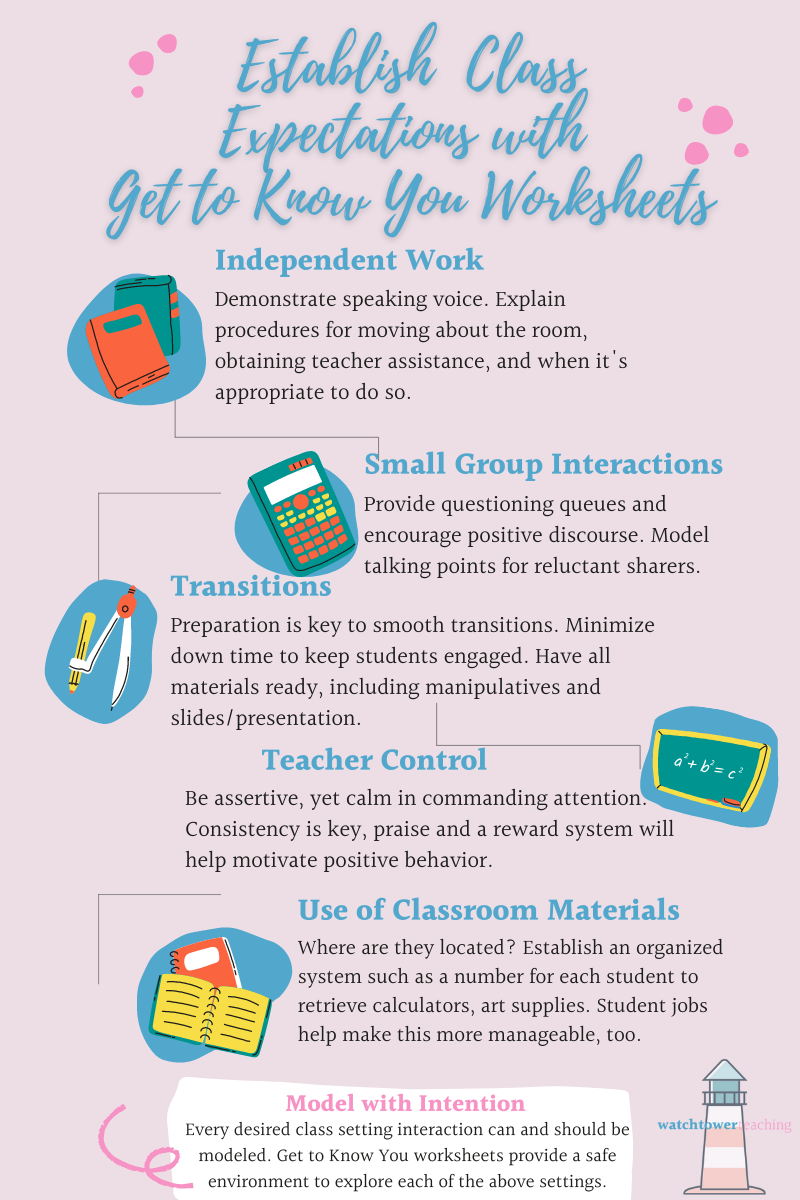
When you remove academic pressure from the classroom, it becomes easier to focus on establishing behavior expectations that will carry your class through the year. A get to know you activity doesn’t elicit a fear of making a mistake, because the activity is personal to them. There are no wrong answers! Instead of concerning yourself with whether or not your students are making progress on the “essential question”, you will have time to communicate your expectations for the following settings:
- Starting an activity
- Working independently
- Communicating in small groups respectfully
- Transitioning from one activity to the next
- Refocusing attention to the teacher when needed
- Obtaining and returning materials in the classroom
For classroom management purposes, you’re going to want to button all of that up anyway – believe me! It’s best to focus solely on the processes of the classroom before the pressures of curriculum hide behind every activity. Take moments to pause, demonstrate and reflect on behaviors taking place in that moment. What used to be a drawn out lecture of college proportions now becomes a dynamic live action example of all the Dos and Don’ts of YOUR classroom!
Students are immersed in the classroom culture – in fact, they take a first hand role in CREATING the classroom culture! Talk about buy in. At each juncture, ASK them, don’t tell them, whether the behavior observed aligns with the math classroom they envision for the year! I promise you, anything adolescents can take ownership of and feel directly involved in, they respect and take more seriously. You’ll be surprised to see, too, that they all want structure and boundaries – they WANT your class to be their safe space of the day!
Observe interactions and activity
Since get to know you worksheets are completed in a whole class individual setting, the activity can be more casual in its administration. Students are free to exhibit their behaviors in a natural way that isn’t hindered by the stresses of a typical mathematics environment. Take this time to circulate the room and be aware of the interactions between the students.
Just wait – you’re going to see right away: Who are my enthusiastic students? Which students are super quiet? Who’s jumping right into an activity? Where is the reluctant learner? Is anybody ACTUALLY following the directions? Even though this is not a mathematical activity, you will get your first glimpse into what type of students you have.
Students may have you clarify expectations on whether or not they are allowed to list a family member for their favorite celebrity. Maybe just to get some validation and a little confidence boost for choosing their “expert” activity because they don’t believe they are an expert in anything. Finally, if you have students with accommodations in your classroom you get a first look at how their abilities shine in your classroom.
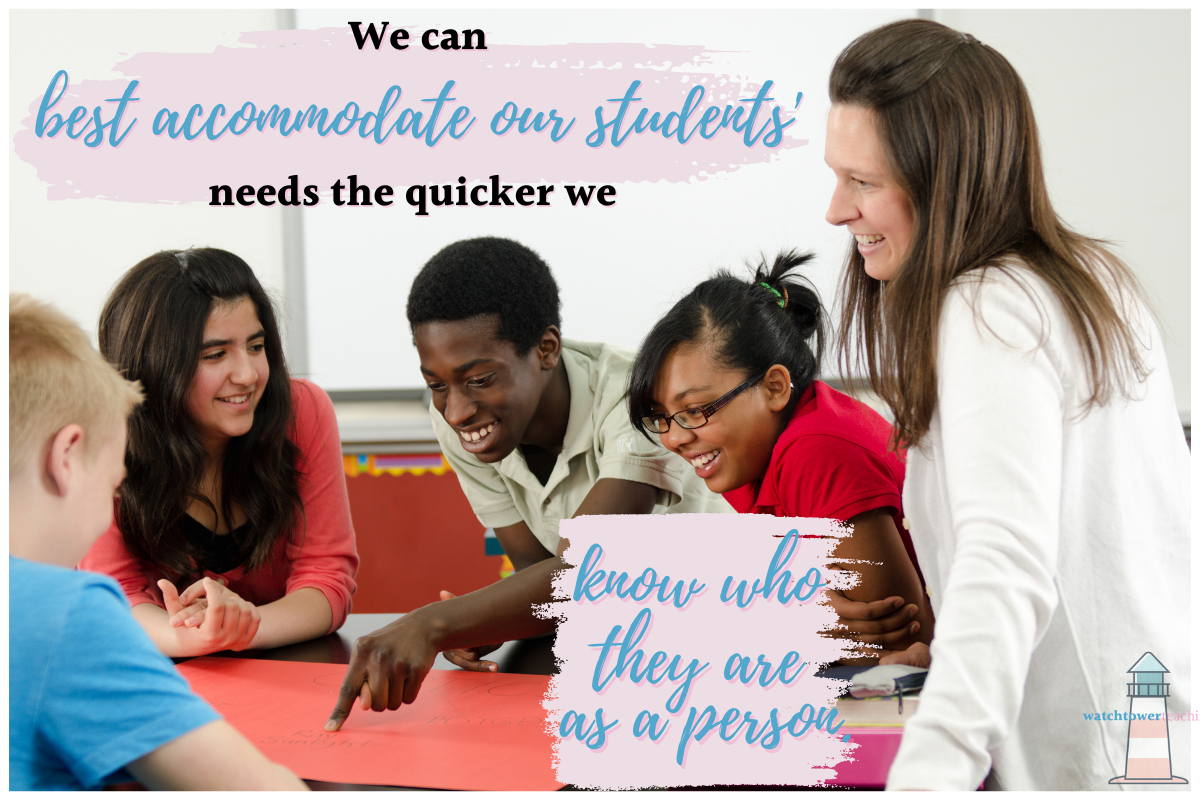
It became very clear to me one year without even getting through reading all of my student documentation that I had an amazingly confident, enthusiastic student that was also in need of assistance with class notes. He was extremely capable, happy to participate and a helpful classmate – a PERFECT addition to a classroom! And this Get to Know You worksheet activity showed me more about him than any document could have. Bottom line – we can best accommodate our students’ needs the more quickly we know who they are as a person.
Utilize the information shared throughout the year
The payoff is in the follow up – isn’t that always the case? Data collection, in general, should be analyzed and used to inform instruction, yes? Get to know you worksheets allow for the same process!
- Display the student work
- Host a Gallery Walk or Classmate Scavenger Hunt
- Use student interests in word problems
- Greet students personally at the door
Once I have enough time to receive the projects, I hang them in the room. The projects now have meaning – the student has a place in your classroom, not just as a mathematician or writer or scientist, but as an individual. They feel pride being in your room. When Meet the Teacher Night or Parent Conferences roll around, they make a great visual for parents, too. I know I FAWN over my son’s work that’s up when I go to his school! Yes – I’m one of those moms! Pride is a real great way to foster connections with students and their families alike.
Now, of course the teacher wants to know the students, but for a comprehensive classroom experience, it’s crucial that your students get comfortable with working together. Not just with their bestie that sits in the next row, but with anybody you may decide to pair them with! My free printable get to know you worksheets include an activity for everything you just read about.
The Get to Know My Class sheet allow students to take a gallery walk or scavenger hunt through the room of displayed work in search of students that have things in common with them, or that they find particularly interesting. Someone they may not have been inclined to work with previously may end up having the same birthday as them! Or maybe they’re both only children.
Middle school can be extremely awkward for some students, and this could make that transition a little bit more comfortable. By the first time I change seating locations, there isn’t a complaint in the room. Everyone is accepted by their peers.
Make sure the fun of Get to Know You worksheets in middle school continues throughout the year. Incorporate the individualized information into your daily routine you can accomplish this. Put student names and their interests into word problems or task cards! Connect with your students as you meet them at the door by mentioning something from their artwork. It may help the shy student open up a bit, or the student who’s had some behavioral struggles to be more willing to give you their best!
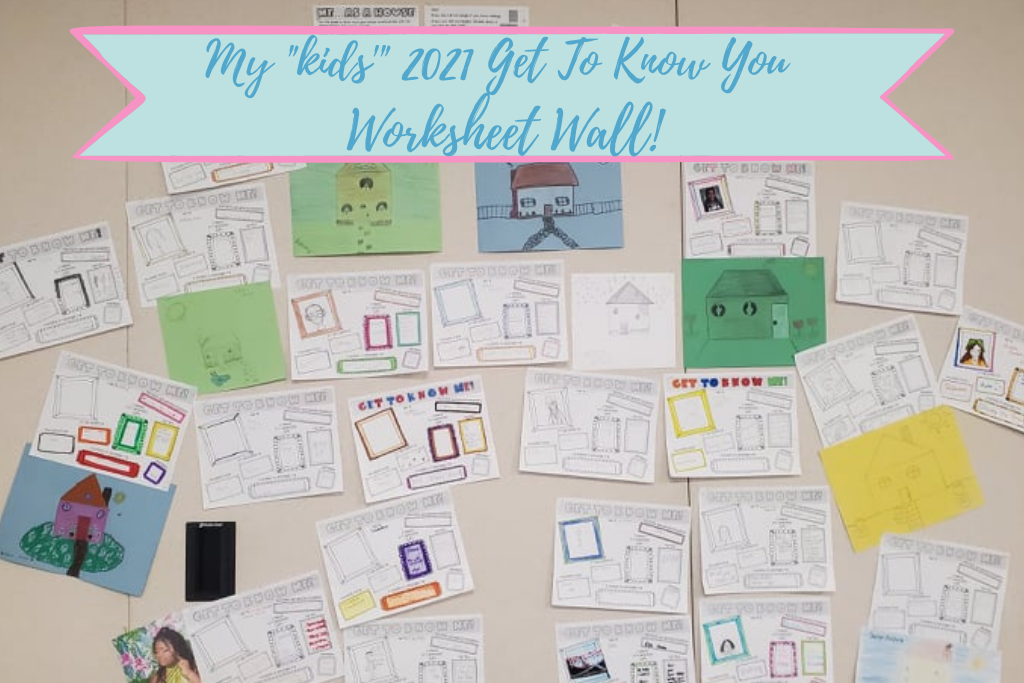
Has the opportunity to implement Get to Know You Worksheets passed?
Short answer – no! It’s never a bad time to use Get to Know You Worksheets. It seems natural to use them at the beginning of the year, right? Well, I’m telling you – kids will love the respite from solving equations whether it’s September 1 or December 1.
If you didn’t have the opportunity to use them right away, wait until after your first exam. By then, you’ve fully established all of your procedural expectations from points A to Z (or lesson to test.) Days like review days, day after a test, or day before a holiday break all make for good days for a lighthearted activity.
Some other ways to implement these worksheets could be as a homework assignment. Use it as a quiet activity when a student finishes their independent work. However, those options forgo the benefits of observing classroom activity and establishing routines through doing it in class.
Explore More Ways to Improve Classroom Community
Examples of Routines and Procedures to Make Your School Year Successful
10 Ideas to Get to Know Your Students
5 Strategies for Building Community in the Classroom
Truly, there is nothing more important than knowing the children you will spend almost an entire year with. Like a family has a dynamic connection between its members, so does a class of teacher and students. The sooner you establish that community through Get to Know You Worksheets, the better!
I absolutely love putting a mindful lens on all teacher related areas and would love to speak to your heart directly. Leave a comment with what you’d like to read more of – after all, I’m here to help you! After reading this, I hope you feel like you know a bit about me. You’re ready to overcome the challenges of teacher burnout. So sign up to receive my free guidebook with my 9 most detailed and actionable steps and planning sheets. I look forward to knowing that your stress will shift to confidently conquering any teacher burnout and stress you may face this year!

